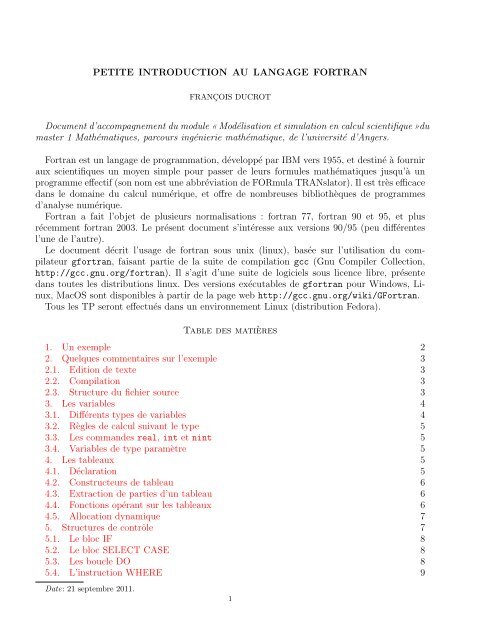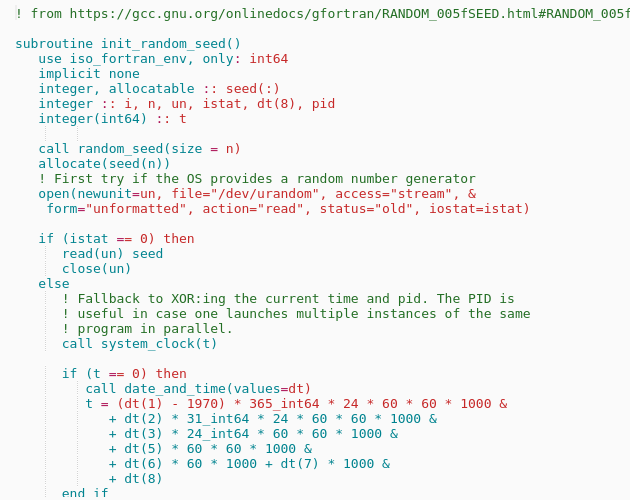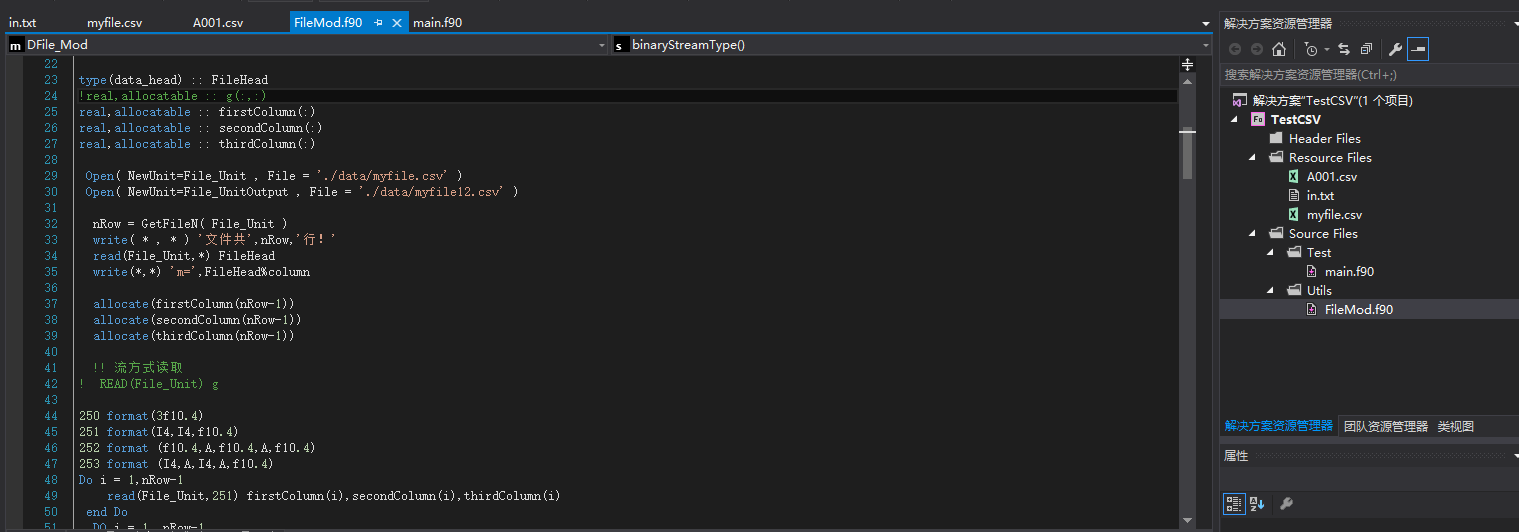The only way to allocate aligned memory in standard Fortran is to allocate it with an external C function, like the fftw_alloc_real and fftw_alloc_complex functions Fortunately, Fortran 03 provides a simple way to associate such allocated memory with a standard Fortran array pointer that you can then use normallyDuring execution of the assignment statement, the variable S is precleared to blank, and then zero characters are moved into S, so S contains one blank; While Fortran 08 has C633 (R631) If allocateobject is an array either allocateshapespeclist shall appear or sourceexpr shall appear and have the same rank as allocateobject If allocateobject is scalar, allocateshapespeclist shall not appear C638 (R626) Each allocateobject shall be type compatible (4313) with sourceexpr

Pdf Avoiding Memory Leaks With Derived Types
Fortran allocate error
Fortran allocate error-The bounds in the shape specification must be scalar integer expressionsFortran 90 Dynamic Memory The size of arrays can now be specified at run time Here's how a typical Fortran 77 program would manage an array whose size could vary at run time For instance,let us allocate an array in the main program and pass it to a subroutine




Introduction To Fortran Jon Johansson Aict Hpc Workshop April 28 Ppt Download
Furthermore, the size of the array (or matrix) returned by the function can be defined using values that are derived from the input parameters This feature is extremely useful when you write functions that return matrices or vectors, whose size depends on the size of inputBecause of the declaration, the intrinsic function LEN(S) will return a length of 1You cannot declare a size of less than 1, so this is the smallest length string variable you can get Fortran allocate large variable memory 2 June, 21 Variables that are larger than a few kilobytes often should be put into heap memory instead of stack memory In Fortran, compilers typically put variables with parameter property into stack memory Our practice in Fortran is to put nontrivial arrays intended to be static/unchanged memory
Fortran provides two ways to allocate memory dynamically for arraysFortran 90 Free Form, ISO Standard, Array operations Fortran 95 Pure and Elemental Procedures Fortran 03 Object Oriented Programming Fortran 08 CoArrays Examples Installation or Setup Fortran is a language which can be compiled using compilers supplied by many vendors DifferentCUDA Fortran Host Code F90 program incTest use simpleOps_m implicit none integer b, n = 256 integer, allocatable a() allocate (a(n)) a = 1 !
Here is a small example of how this library makes Fortran easier to use (especially for a beginner), and how it can clean up your code While this example is not extensive it should give you an idea Fortran code to allocate an array, create some numbers, and compute their meanAnswer (1 of 9) Yes, definitely However, the syntax is completely different and so are most of the semantics Here are the most important differences Fortran uses the code Allocate/code statement, not a code malloc()/code or code calloc()/code function OnceRead(*,*) Nparticles allocate (charge(Nparticles),xyz(dim,Nparticles)) Order of Array Indices {from CVF manual) Make sure multidimensional arrays are referenced using proper array syntax and are traversed in the "natural" ascending order column major for Fortran With columnmajor order, the leftmost subscript varies most rapidly with a stride




Walking Randomly Fortran




Petite Introduction Au Langage Fortran Document D
2 an ALLOCATE statement to allocate the temporary array to the new size you want 3 one or more statement to transfer the data you wish to keep from the old array to the new 4 a call to MOVE_ALLOC to make the new allocation now be the one referred to by your "permanent" allocatable arrayFortran provides dynamic allocation of storage;Arrayvalued functions functions that return arrays Functions in Fortran 90 can even return arrays (or matrices) !




Cuda Fortran Programming With The Ibm Xl Fortran Compiler Ppt Download




Fortran 41 Programs With Arbitrary Sized Arrays Using Allocate Deallocate Statements Youtube
23 Fortran features — Fortran Coding Standards for JULES 23 Fortran features ¶ The following is a list of Fortran features that you should use or avoid Use IMPLICIT NONE in all program units This forces you to declare all your variables explicitly This helps to reduce bugs in your program that will otherwise be difficult to track POINTER Fortran Statement and Attribute Specifies that an object or a procedure is a pointer (a dynamic variable) A pointer does not contain data, but points to a scalar or array variable where data is stored A pointer has no initial storage set aside for it;Lahey/Fujitsu Fortran DEALLOCATE Statement Description The DEALLOCATE statement deallocates allocatable arrays and pointer targets and disassociates pointers jp integer allostat allocate (ip(10,),jp(10)) deallocate(ip) deallocate(jp,stat=allostat) write(*,*) allostat See Also Allocate Statement Send comments on this topic



1




Example Of Fortran Code And Device Variable Point Wise Expression Download Scientific Diagram
Fortran 90 Tutorial The dimension of an array may be specified by a type specification statement of the form REAL, DIMENSION (10) A, B INTEGER, DIMENSION (09) C Here, the three arrays A, B, and C have each been dimensioned with 10 storage slots The index of the real arrays A and B start at 1 while the index for the integer array C ObjectOriented Programming in Fortran 03 Part 2 Data Polymorphism Original article by Mark Leair, PGI Compiler Engineer Note This article was revised in March 15 and again in January 16 to bring it uptodate with the production software release and to The overhead of using ALLOCATE and DEALLOCATE is the same as the overhead of using malloc() and free() in C Actually most Fortran compilers implement (DE)ALLOCATE as wrappers around malloc()/free() with some added bookkeeping, inherent to all Fortran 90 arrays Usually it is better to preallocate a big enough scratch array and use it in tight loops instead of




Heap Allocator An Overview Sciencedirect Topics




Application Of Fortran 90 To Ocean Model Codes
Fortran 90 allocate Fortran 90 allocateFortran 90/95 Deallocating variables Ask Question Asked 7 years, allocating and deallocating memory takes time so it is not advisable to repeatedly allocate and deallocate an array unless there is a good reason to do so Finally, as you mentioned, the operating system will reclaim all memory used by theUsing Array Space in Subprograms As I mentioned before, Fortran simply passes the address of a variable to a subroutine This makes it easy to allocate space for an array at one level in your program, and then use that space in subroutines called or functions used by that levelStat_variable A scalar integer variable errmsg_variable (Fortran 03) A scalar character variable source_expr (Fortran 03) An expression which is scalar or has the same rank as allocate_object i_d_type_spec (Fortran 03) Is an intrinsic_type_spec or derived_type_specSee Type Declaration for a list of possible type specifications




Introduction To Fortran Ppt Download




Fortran Programming Tutorials Revised 024 Formats Arrays Allocate Limits Of Int Youtube
When the Fortran 90 standard was being established, there was a request for this feature What we got was something a little different, in many respects more powerful, and in some respects intentionally crippled One underlying theme of new Fortran 90 constructs has been isolation of users from the details of memory allocationThe FORTRAN 77 Standard prohibits opening a named file as scratch if OPEN has a FILE=name option, then it cannot have a STATUS='SCRATCH' option This FORTRAN extends the standard by allowing opening named files as scratch @ Such files areLahey/Fujitsu Fortran ALLOCATE Statement Description The ALLOCATE statement dynamically creates storage for array variables having the ALLOCATABLE or POINTER attribute If the object of an ALLOCATE statement is a pointer, execution of the ALLOCATE statement causes the pointer to become associated If the object of an ALLOCATE statement is an




Figure 3 Automatic Fortran To C Conversion With Fable Springerlink




How To Find Equation Of Straight Line Fortran Ssest Explanation Youtube
Intel® Fortran Compiler Classic and Intel® Fortran Compiler (Beta) Developer Guide and Reference Developer Guide and Reference Version 214Execution of an ALLOCATE statement for a pointer causes the pointer to become associated with the target allocated For an allocatable object, the object becomes definable The number of dimensions specified (ie, the number of upper bounds in allocation) must be equal to the rank of allocate_objectWhen an ALLOCATE statement is executed for an array, the values of the fortran allocation, unknown a priori DIMENSION I want to generalise allocation of a variable which may have different number of dimension To do so I created an interface having different procedures which are called depending of the SIZE of DIMS (the array of the dimensions)




Fortran 90 Arrays




5 Reasons Why Fortran Is Still Used
Intel Fortran Composer XE 11 up to Update 5 (compiler 1) Coarray Fortran, additional 03 (FINAL subroutines, GENERIC keyword,) and 08 (Coarrays, CODIMENSION, SYNC ALL, SYNC IMAGES, SYNC MEMORY, CRITICAL, LOCK, ERROR STOP, ALLOCATE/DEALLOCATE) Intel Fortran Composer XE 11 Update 6 and above (compiler 121)Status is an integer variable whose value is 0 if the allocation or deallocation was successful PDF Download Fortran for free Previous NextThe DIMENSIONAttributeAttribute 1/61/6 zA Fortran 90 ppgrogram uses the DIMENSION attribute to declare arrays zThe DIMENSIONattribute requires three components in order to complete an array specification, rank, shape, and extent zThe rank of an array is the number of "indices" or "subscripts" The maximum rank is 7 (ie, sevendimensional)




Codeblocks Fortran Tutorial




Analyzing Stock Price Time Series With Fortran Arrays Part 2 Manning
It relies on a heap storage mechanism (and replaces another use of EQUIVALENCE) An example for establishing a work array for a whole program is An example for establishing a work array for a whole program isWe can also allocate the size of the array at run time by dynamically allocating memory FORTRAN actually allows the use of arrays of up to 7 dimensions, a feature which is rarely needed To specify a extended precision 3 dimensional array b with subscripts ranging from 1 to 10, 1 to and 1 to 30 we would writeFortran has an advantage over C or C for array processing, because it has high level array features in the language, including allocatable arrays and array assignments After allocating an array, you can easily initialize the whole array with a single assignment statement, or copy one array to another, or easily compute an arrayvalued




Analyzing Stock Price Time Series With Modern Fortran Part 2 By Milan Curcic Modern Fortran Medium




Introduction To Fortran Serial Programming A Simple Example
That is, that it is not possible to segfault in deallocate () This is happening under absoft f90 in linux The machine is a dualAn allocate shape specification is lowerbound upperbound A DEALLOCATE statement is DEALLOCATE (allocateobjectlist , STAT = scalarintegervariable ) Things to Know Each allocate object must be an allocatable array or a pointer;Dynamic memory allocation So far in our examples the array dimensions have been defined at compile time memory allocation is static;




Example Of Fortran Code And Device Variable Point Wise Expression Download Scientific Diagram




Fortran Dynamic Arrays
Silverfrost > Documentation > Fortran Help > Fortran 95 > Dynamic storage allocation Dynamic storage allocation Allocating storage for arrays If the required size of an array is not known at compile time, it can be declared with the ALLOCATABLE attribute For exampleIf an array size depends on the input of your program, its memory should be allocated at runtime memory allocation becomes dynamic;F90 Program StructureF90 Program Structure zA Fortran 90 program has the following formA Fortran 90 program has the following form programname is the name of that program specificationpart, executionpart, and subprogrampart are optional Although IMPLICIT NONEis also opp,tional, this is required in this course to write safe programs PROGRAMprogramname




Application Of Fortran 90 To Ocean Model Codes




Pdf Mcfor A Matlab To Fortran 95 Compiler Semantic Scholar
Answer (1 of 2) Fortran 77 does not support dynamic memory allocation But many Fortran 77 compilers support a nonstandard extension known as "Cray pointers" With these you can interact with C and use malloc or mmap Fortran 90 supportsMPI_Win_allocate is a collective call executed by all processes in the group of comm On each process, it allocates memory of at least size bytes, returns a pointer to it, and returns a window object that can be used by all processes in comm to perform RMA operations The returned memory consists of size bytes local to each process, starting atFortran Dynamic Arrays A dynamic array is an array, the size of which is not known at compile time, but will be known at execution time Dynamic arrays are declared with the attribute allocatable The rank of the array, ie, the dimensions has to be mentioned however, to allocate memory to such an array, you use the allocate function




5 Analyzing Time Series Data With Arrays Modern Fortran Building Efficient Parallel Applications




Fortran Wikipedia
ALLOCATED (The GNU Fortran Compiler) Description ALLOCATED (ARRAY) and ALLOCATED (SCALAR) check the allocation status of ARRAY and SCALAR, respectively Standard Fortran 90 and later Note, the SCALAR= keyword and allocatable scalar entities are available in Fortran 03 and later Class Inquiry function SyntaxWww Tacc Utexas Edu Documents Fortran Class Pdf Fortran allocate pointerThe STAT= option Immediately before deallocation, allocated () returns True As I understand it, STAT= should cause the deallocation to return control to the program, even if it failed;




Data Structuring In Fortran Springerlink




Fortran Tutorial Youtube
Fortran 03 is a major extension of Fortran 95 This contrasts with Fortran 95, which was a minor extension of Fortran 90 Beside the two TR items, the major changes concern object orientation and interfacing with C Allocatable arrays are very important for optimization – after all, good execution speed is Fortran's forte




Language Reference




Problems With Allocatable Arrays Real8 Accessing Ranges Not Allocated In Arrays In Fortran Intel Community



Add Deallocate Reallocate Option To Allocate Issue 61 J3 Fortran Fortran Proposals Github




Example Illustrating The Handling Of Common Variants By Emulating The Download Scientific Diagram



2



Fortran




Implementing Subprograms In Text Chapter 9 1 Outline



Lahey Gnu Fortran Lassen Edition Windows 32 64 Bit




Towards Exascale Computing With Fortran 15




Fortran 90 For Scientists And Engineers Author Brian D Hahn Apr 1994 Amazon Com Books




Pdf Avoiding Memory Leaks With Derived Types




Fortran Array Allocation Overflow Stack Overflow




Pdf Generic Programming In Fortran 90 Arjen Markus Academia Edu



1




Fortran 95 Initialize A Pseudo Random Number Sequence Codepad



1




Fortran 90 Arrays




Bol Com Fortran 90 For Scientists And Engineers Ebook Brian Hahn Boeken



Performance Of Rank 2 Fortran 90 Pointer Arrays Vs Allocatable Arrays Unt Digital Library



2




Allocate Multiple Arrays With Single Shape Stack Overflow




Intel Fortran Compiler For Linux And Macos




Write Function In Fortran Stack Overflow




An Introduction To Pointers Springerlink




Why Does A Subroutine With An Array From A Use Module Statement Give Faster Performance Than The Same Subroutine A Locally Sized Array Stack Overflow




Vlaams Supercomputer Centre Mooc And Free Online Courses Mooc List




Introduction To Fortran Jon Johansson Aict Hpc Workshop April 28 Ppt Download




Walking Randomly Fortran



Modernizing Old Fortran In Fortran Wiki




Introduction A Fortran 90 Pdf Free Download




Introduction Modern Fortran Short




Support De Cours Du Langage Fortran Pour Les Nuls




Solved Debug Issue Relating To Allocatable Variables In User Defined Type Constructs Status Intel Community




1 Procedure Calls Memory Allocation Calling Conventions Parameters Environments And Cute Tricks Ppt Download



Fortran90 Computational Fluid Dynamics Is The Future



Petite Introduction Au Langage Fortran Pdf Free Download




Pass A Fortran Derived Type Which Contains Allocatable Array Between Different Compilers Pgi And Intel Stack Overflow




Fortran 90 Decision Structures Astronomy Group Pw31 Compastro Lecture 5 Pdf Nbsp As3013 F90 Lecture Pdf Document




The Fortran 90 Programming Language Book Chapter Iopscience




Program Fortran 90 Implementing The Quick Sort Algorithm Download Scientific Diagram




Fortran 90 Pdf Document




Example Illustrating The Handling Of Common Variants By Emulating The Download Scientific Diagram




Elements De Programmation Fortran




Debugging Fortran Code Using Code Blocks Ide Youtube




Solved Nested Allocatable Type With Allocatable Components Intel Community



Mvs 3 8j From A Business Programmer Perspective




Comando Allocatable Para Fortran Youtube




How To Program In Fortran With Pictures Wikihow




Application Of Fortran 90 To Ocean Model Codes




Simple Custom Linked List In Fortran Unexpected Behavior Stack Overflow




Fortran 90 And Computational Science Sherrill Fortran 77 Control Structures Numeric Processing




Fortran读取csv文件 30年磨一剑



2




Modernizing Modularizing Fortran Codes With 03 Standards




Lenguajes De Programacion Fortran 90 95 Ppt Descargar




Ppt Fortran 90 95 And 00 Powerpoint Presentation Free Download Id




Fortran 90 Gotchas Part 3 Acm Sigplan Fortran Forum




Solved Allocatable Character Problem Intel Community




Access Violation When Writing To A Fortran Allocatable Array Stack Overflow




Introduction To Fortran Serial Programming A Simple Example




Data Structuring In Fortran Springerlink




Introduction Modern Fortran Short




Data Structuring In Fortran Springerlink




Data Structuring In Fortran Springerlink



2




Application Of Fortran 90 To Ocean Model Codes Mark Hadfield National Institute Of Water And Atmospheric Research New Zealand Ppt Download




Fortran 90 Yetmen Wang Fortran 90 95 00 Introduction Fortran Versions Program Structure New Source Form Oo Programming Array Programming Significant Ppt Download




Fortran 77 Le Lt Ge Gt Ne Eq




Introduction To Cfd Fortran Code




Solved Allocation Inside Select Rank Intel Community




Run Time Memory Allocation And Array Processing In Fortran Math 248 Docsity




0060 0068 Pdf Pdf Parameter Computer Programming Subroutine



Run Time Memory Allocation And Array Processing In Fortran Math 248 Docsity



Debogage En Fortran




Cop40 Programming Languages Ppt Video Online Download




How To Allocate An Array In Fortran Youtube




Jacobi Program In Fortran Pdf



Changed Features Hp Fortran 77 Ix Migration Guide



0 件のコメント:
コメントを投稿